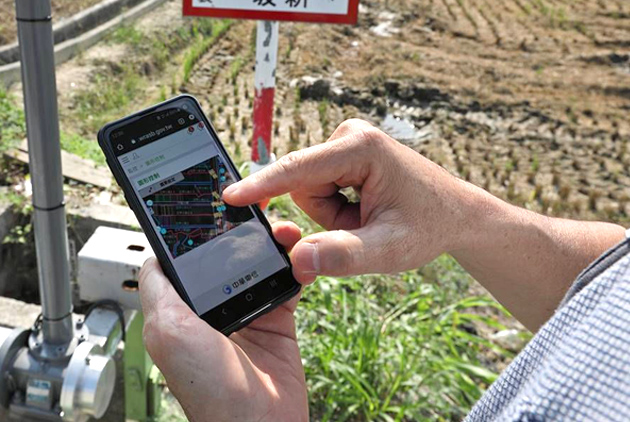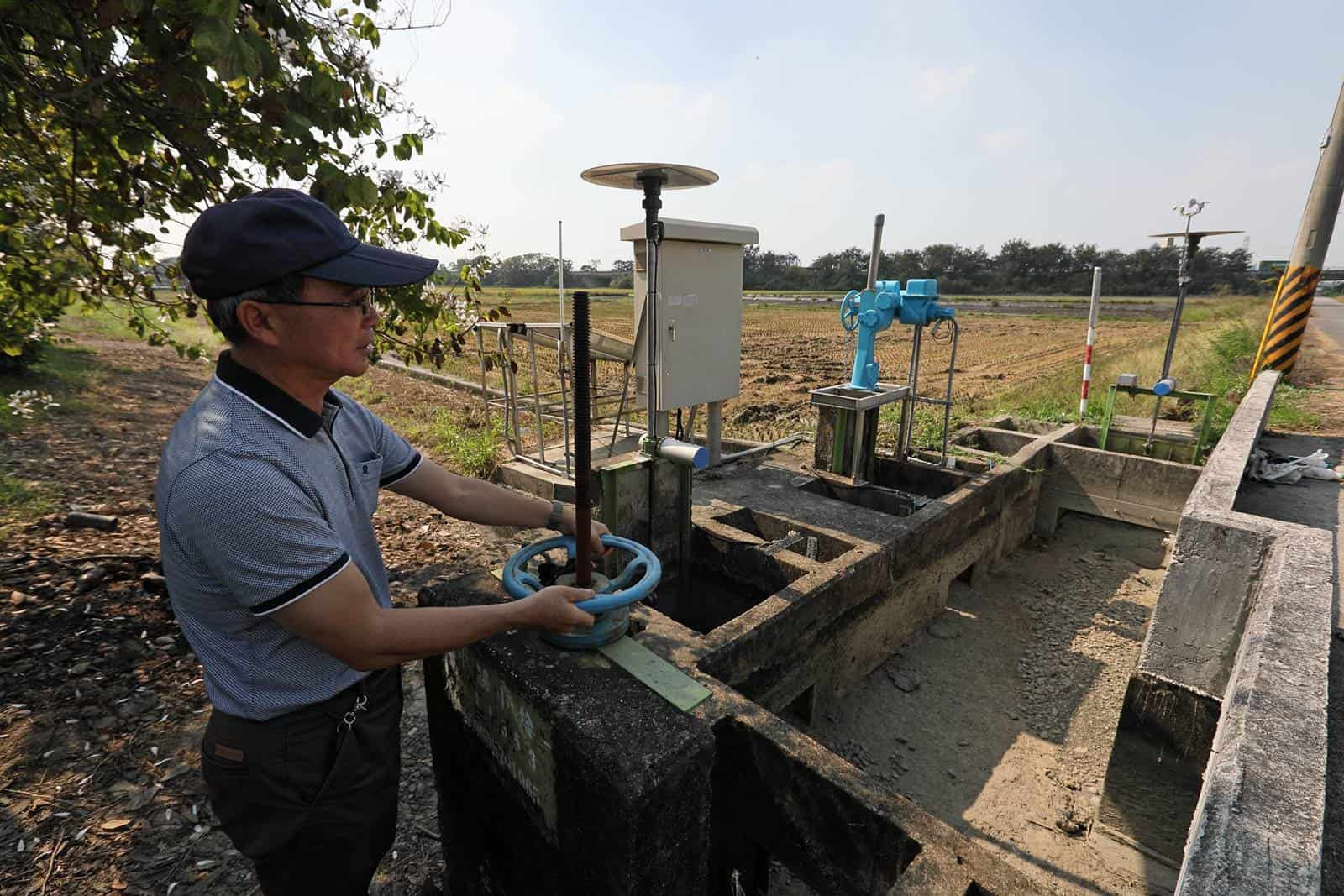TSMC Helps Water-Starved Taiwan Develop Smart Irrigation

Source:Chien-Tong Wang
2020 is the driest year in more than half a century. How did Taiwan Semiconductor Manufacturing Company (TSMC) make irrigation possible amidst a drought?
Views
TSMC Helps Water-Starved Taiwan Develop Smart Irrigation
By Rebecca Linweb only
The monitor on the wall shows blue and red lines criss crossing scattered fields, with blue and yellow signs blinking here and there. A long list at the bottom of the screen on the right shows whether the water in sluice gates, diversion devices and ditches is at a normal level.
“I only need to look at the screen every day to know whether the water situation is normal,” explains Chen Yen-hsing, head of the Longtian Work Station of the Jianan Irrigation Association as he points at the monitor. Chen and his colleagues at the work station, known as canal controllers, all use a smartphone app to monitor the water situation within their purview. Once a red signal alerts them that a ditch holds too much water, it only takes two moves to close the respective sluice gate via remote control.
A smartphone and a computer dramatically changed the time-honored irrigation practices within the Jianan Irrigation Channel system. In 2016, the Water Resources Agency launched a four-year project at the Longtian Work Station with the goal to improve the conservation of water for irrigation. Control equipment, sensors and wireless transmission were installed to strengthen irrigation management. Among those backing up the project was TSMC, the world’s largest chip foundry and Taiwan’s pride.
The Guardians of Water Resources
In 1920, during the Japanese colonial period, Japanese engineer Yoichi Hatta designed the Jianan Canal and the Wushantou Reservoir which greatly improved the water supply system. With ample water available for irrigation, paddy rice cultivation became possible, turning the Jianan Plain into Taiwan’s rice barn. This complex and efficient irrigation scheme remains in place today, one century later.

During drought periods, the canal controllers act as guardians of the water resources. Wang Ren-yi has worked in this job for more than a decade. “As soon as they release water from the reservoir, I get busy,” he says. Riding a scooter, Wang needs to patrol the ditches. If he finds them clogged with garbage or twigs and branches, he needs to remove the obstacles to ensure a free flow of water.
“Sometimes during a typhoon or in the middle of the night, the canal controllers still need to go out to close the floodgates. The probability of accidents is quite high,” says workstation boss Chen.
This year, central and southern Taiwan are experiencing an extreme drought. And when it rains, it rains in the lowlands and not in the mountains where the reservoirs are located. Therefore, the canal controller rush out to monitor the ditches and close the floodgates as soon as it begins to rain to reduce the amount of water that is released from the reservoirs. As a result, they were able to conserve 90 million tons of water, which equals the capacity of the Nanhua Reservoir in Tainan.
But given that the vast majority of canal controllers near retirement there is no way around introducing technology to make up for manpower shortages. “If we made the farmland irrigation system automatic and smart and combined it with a data feedback platform then we would be able to know where irrigation is delivered unevenly,” notes Hsu Hsiu-chen, section chief with the Water Section of the Southern Region Water Resources Office. The irrigation water conservation improvement project is still in its experimental stage and its coverage has been expanded from 50 hectares to 110 hectares so far.

Under the scorching sun, the reporter follows Chen to the farmland irrigation area. A sign with white characters on green paint reads “Zhongxie small ditch”, with Zhongxie being a neighborhood in the Guantian District of Tainan. A blue water tap is secured with a rusty chain. “In the past, people had to come here in person to open or close the floodgates. Since water was often stolen, we needed to use a chain with a lock,” explains Chen.
TSMC Assists Water Conservation Effort
The Water Resources Agency commissioned the development of an automated floodgate to experiment with smart irrigation. The equipment features a heavy stainless steel plate with a solar panel, and is flanked by a component that looks like a car battery on each side.
“This set of equipment costs NT$460,000 and is huge,” remarks Yeh Chun-ming, deputy division chief with the Water Resources Agency’s Water Administration Division. TSMC dispatched manager-level employees to collaborate on the project. “We told them what we needed, and they made it.”
TSMC suggested that power consumption could be substantially reduced so that a smaller motor and solar panel could be used if the time needed to open or close the gate were extended from originally one minute to half an hour. Installed above the new gate, which looks much lighter and nimbler, is a solar panel that is smaller than a parasol. The cost of the equipment has been halved although it also comprises sensors to measure the temperature, humidity, and wind direction.
Not just the smart gate but also the vertically sliding diversion device and the discharge monitoring equipment which controls the flow were also developed by TSMC.
Using Internet-based monitoring equipment, Chunghwa Telecom collects data about the flow in field ditches, the volume of water used for irrigating farm plots, and local weather conditions to build a database and a cloud management platform.
“The workstation boss can remain on top of the water supply situation via cloud monitoring and close the gates when necessary. The canal controllers no longer need to patrol everywhere on their scooters,” says Hsu.

Smart irrigation has become the perfect helper for the workstation and its staff. “Now we only need to tap a button to control the outflow,” says Wang, taking out his smartphone to demonstrate the working of the app. As he touches the screen the term “sluice gate control” pops up with three options in the menu – open, close, stop, and then there is “setting sluice gate aperture”. From now on, the smartphone replaces the scooter.
However, smart irrigation remains quite costly. Yeh reveals that the water conservation ratio stood at around 5 percent to 10 percent during the experiment, with the entire system from gates to field ditches fully rolled out. This translates into a cost of NT$10.5 per metric ton of water which is about the current price of tap water. In the future, the price could be lowered to NT$6.1.
As part of the Forward-looking Infrastructure Development Program, the government has already earmarked NT$79 million for smart irrigation. In the coming four years, the program will be expanded from 110 hectares to 1300 hectares. “Since the canal controllers keep growing older and young people are not very keen on taking over, this system will prove more and more beneficial in the future because it makes up for the manpower shortage,” explains Yeh.
In the past, agricultural irrigation was often criticized for its high conveyance loss due to seepage and spillage. As dry spells occur more often now, water resources become much more precious so that not even a single drop of water should be wasted. The technological advances that are revolutionizing the century-old irrigation management system might become the guarantor of its future.
Have you read?
♦ The Nonagenarian Taiwan Billionaire Pioneering Biodegradable Plastics
♦ Taiwan Needs More than TSMC
♦ The Top Taiwanese App Company You Never Heard Of
Translated by Susanne Ganz
Uploaded by Penny Chiang






